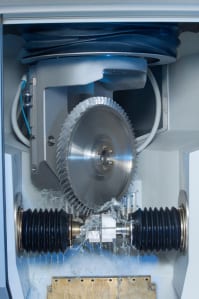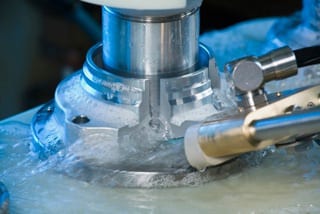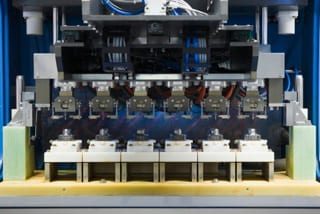Contact us today:

(847) 934-4500
tdaro@bernardandcompany.com

Contact us today:
(847) 934-4500
tdaro@bernardandcompany.com
Add EMAG to your IMTS show planner HERE.
FARMINGTON HILLS, MI – At IMTS 2014, EMAG will feature Manufacturing Systems for Precision Metal Components with multiple machines from its new modular standard VL and VT product families on display. These Modular Standard Machines offer a systematic approach that is advantageous to establishing a highly efficient manufacturing process, with different operations offered on the same platform allowing for easy interlinking and eliminating any great outlay for automation.

The VL 2 Vertical Turning Machine from EMAG is designed for the quality- and cost-conscious manufacturer and sub-supplier: a universal production aid that impresses with its small footprint and advantageous price-performance ratio – automatic workhandling included.
The VL vertical pick-up lathe series opens up new opportunities for the machining of a wide range of chucked components. Small gearwheels, planetary gears, sun gears, sliding sleeves synchronizer rings or flange components, for example, can be machined with great efficiency. The smallest lathe of the VL product family, the VL 2, machines workpieces with a maximum diameter of four inches and a length of up to six inches. Increasing in size, the VL 4, VL 6 and VL 8 offer a number of different turning and milling operations within the framework of a single closed-loop production process. Specially designed for the handling of large components the largest vertical turning machine of the series, the VL 8, ideal for commercial vehicle production, handles workpieces up to 16 inches in diameter and 12 inches in length.
Built within the same modular concept is the VT-Series for machining large quantities of shaft components. With four axes, a self-loading turret and integrated automation, the VT 2-4 machines shafts with a max diameter of 2.5 inches and 16 inches in length. Spindle speeds of up to 6,000 rpm achieve extremely short cycle times as the shaft is clamped vertically between workspindle and tailstock and machined from two sides. The vertical alignment of the workpiece ensures process integrity, where the unhindered chip flow prevents the build-up of chip nests in the machining area.

Machining area of the VL 2: 12 turning or, alternatively, up to 12 driven drilling and milling tools can be employed to carry out a large number of operations in a single setup. The machine can also be equipped with an optional Y-axis.
All machines of the VL and VT product families offer the same advantages for every size workpiece:

The VLC 200 H is designed for the machining of gear-type workpieces of maximum 200 mm diameter and module 4.
Integrating the technologies of the EMAG Group into these new modular standards, the VLC 200 H will make its North American debut at the McCormick Center. The VLC 200 H hobbing machine integrates EMAG-KOEPFER technology into the EMAG vertical platform, including the pick-up design where the main spindle removes the raw part from the conveyor belt, transfers it to the tailstock flange and removes it from the machining area after the completion of the hobbing cycle. Gears with a maximum diameter of 8 inches and module 4 can be dry-milled at greatly shortened cycle times.

Machining area of an EMAG PO 900 BF for the machining of blisks using Precise Electro-Chemical Machining (PECM) technology.
EMAG will also present its entire portfolio of production technologies, from turning, hobbing and grinding to those that complement traditional metalworking processes, such as its production Laser Welding, Heat Shrink Technology and Electro-Chemical Machining (ECM) capabilities. ECM processes offer non-contact machining with no heat affected zone or mechanical stress to components with no tool wear. An ECM machined blisk will also be on display.
EMAG invites manufacturers to visit them at booth N-6846 to meet with technology experts to discuss production solutions for the automotive and commercial vehicle, aerospace, and oilfield industries. For more information on the entire EMAG Group portfolio, visit www.emag.com
Add EMAG to your IMTS show planner HERE.
For more information on this information, please contact:
Kristal Kilgore
EMAG LLC
38800 Grand River Avenue
Farmington Hills, MI 48335
Tel: (248) 875-0313
Fax: (248) 477-7784
E-mail: kkilgore@emag.com
Web: www.emag.com
Increasing demands made on precision and the push for the decrease of price of modern components is pushing traditional manufacturing processes to their limits. From September 10th-15th, 2012 at IMTS in Chicago, IL, EMAG will present three production technologies that complement or replace traditional processes such as turning, milling and grinding.

The ECM process is used to deburr components only at the points where material needs to be removed, and without it having any mechanical or thermal impact on the workpiece.
PECM for nickel- and titanium-based alloys
With its PECM technology (Precision Electro-Chemical Machining) EMAG presents a production process that opens up completely new fields of application. PECM is a process for the machining of high-alloyed materials, such as nickel- and titanium-based alloys. The disadvantages of traditional metal cutting – tool wear, mechanical stresses, micro-fissuring caused by heat, oxidization layering and the need for subsequent deburring operations – are eliminated, because this process is a non-contact one without heat input. All electro-chemical machining processes are characterized by stress-free material removal, smooth transition points and surfaces without ridge formations.

Six in one – the EMAG ECM deburring process can be adjusted to suit individual production requirements.
The advantages that the PECM process provides for different branches of industry are best shown with the example of a turbocharger for the automotive industry. The electro-chemical process is one that can be used to effectively in the machining of many high-alloy components, especially those in the high-temperature sector of the turbocharger – it also offers a much shorter and very efficient process chain. The typical clean-up operations necessary when traditional machining processes are used – such as deburring after milling – are no longer necessary. PECM machining operations are burr-free. And there is hardly any tool wear. The result: downtimes are minimal, when compared to milling (which requires regular tool changes). The process as a whole is sturdier and less prone to errors. And another important factor that our example of the turbocharger shows: the superb surface finish of the PECM process, where Rz-values of 0.3 micron can be achieved.
Will camshafts ever again be made of a single piece?
Another highlight is EMAG‘s heat-shrink assembly technology, a process that scores particularly well in camshaft production. The high degree of precision achieved with the joining process drastically reduces the number of cam profile grinding operations or – with the use of precision cams – avoids them altogether. Another benefit of the process is the ability to combine different materials in the construction of the shaft, such as forged cams (e.g. in 100Cr6) and sintered cams, which do not require regrinding. Accessory components, such as plugs and end pieces, can – like the shaft itself – also be made of better materials. This allows for the camshaft to be adapted to the requirements of the engine and to be optimized in load bearing capacity and manufacturing costs.
Operating costs reduced by 50 %
Production laser welding is already a highly productive process in the manufacturing of gearwheels. The use of diode-pumped solid-state lasers – such as disc or fiber lasers –reduces operating costs by up to 50%. EMAG has been involved with the use of solid-state lasers in the welding of powertrain components from an early stage and is considered a pioneer in the technology. EMAG again has fulfilled a promise to their users offering them the lowest possible cost-per-piece, by coming up with an innovative technology that brings true cost benefits.
For many applications, solid-state lasers allow welding without shielding gas. This not only reduces operating costs, it also avoids having to follow the annoying logistics imposed by the use of shielding and laser operating gasses. In many cases, the welding process can also be sped up considerably. This increases productivity and – through a reduction in energy input per unit length – reduces welding distortion, resulting in better component quality.
For more information:
EMAG LLC
38800 Grand River Avenue
Farmington Hills, MI 48335
Tel: (248) 875-0313
Fax: (248) 477-7784
E-mail: info@usa.emag.com
Web: www.emag.com
Attention: Peter Loetzner
Continue reading